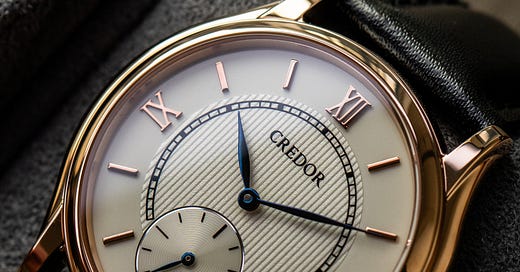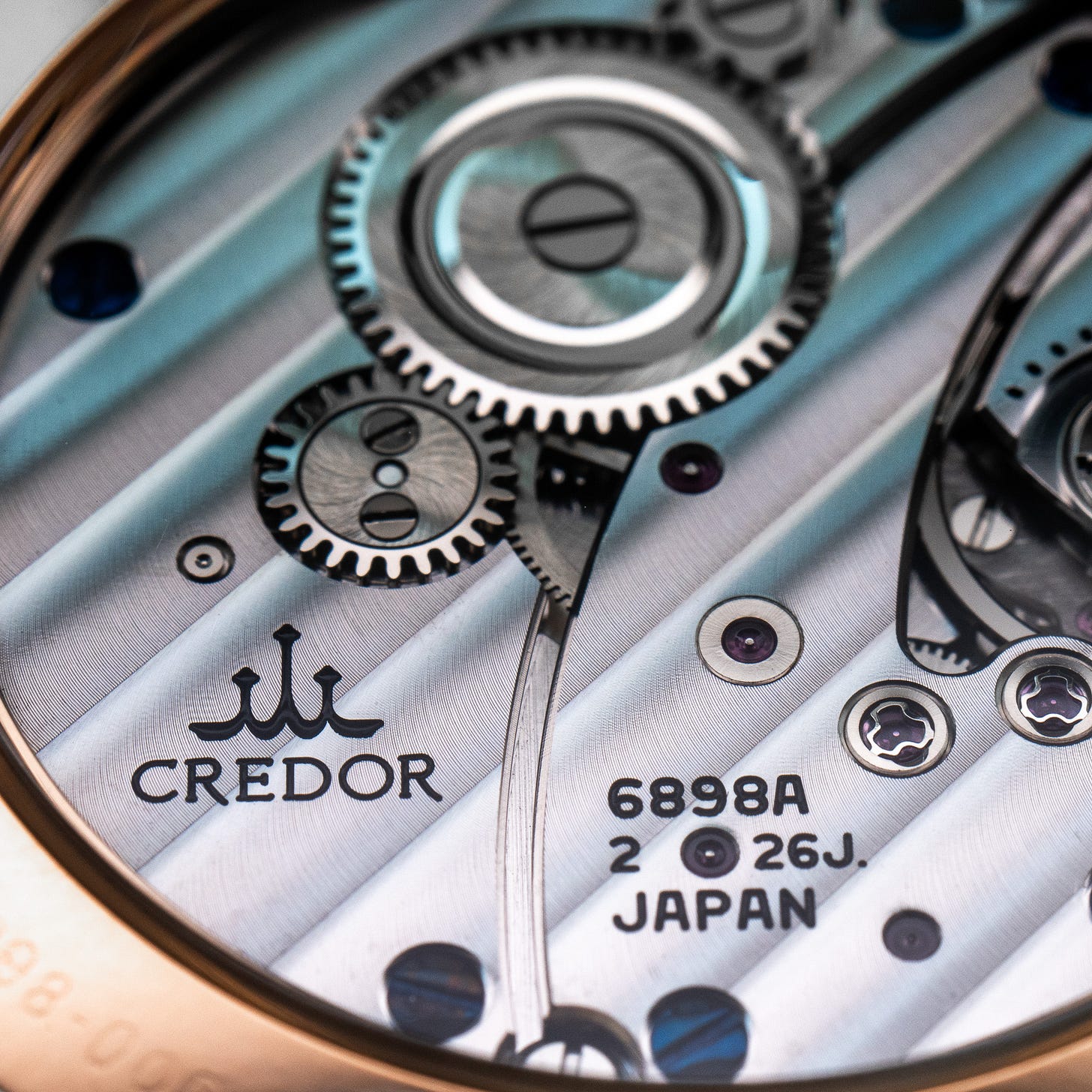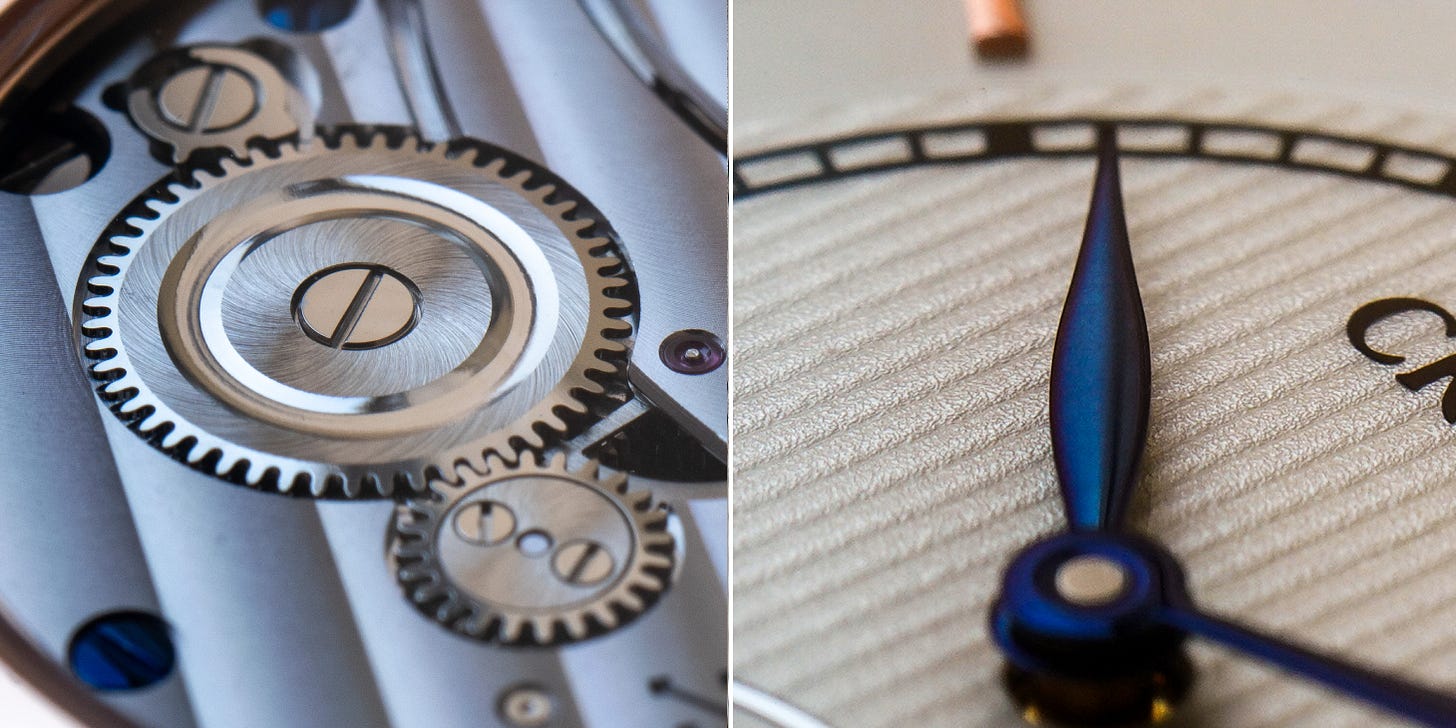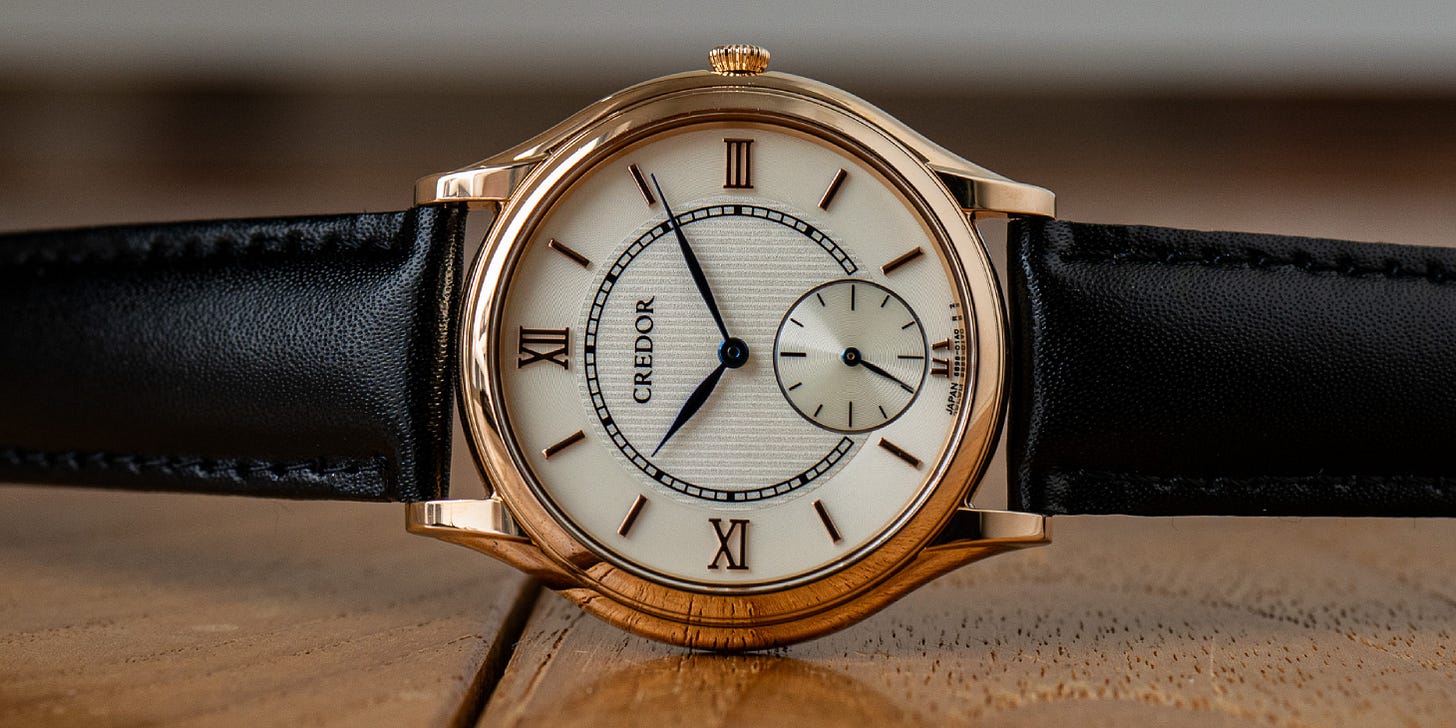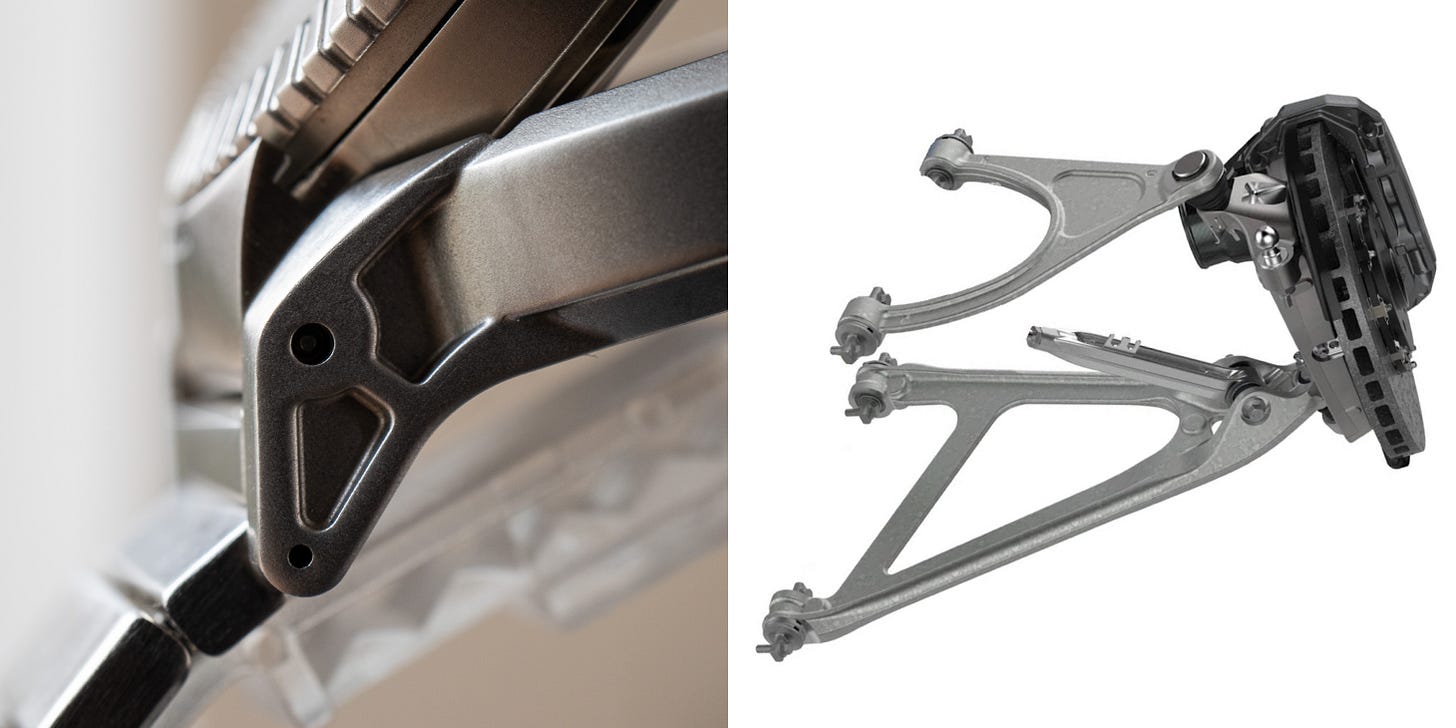The Precursor
I am beyond excited to debut this week’s featured watch. It’s like the Lapita Rainforest Watch - but several orders of magnitude rarer. So rare, in fact, that the Japanese auction house I bought it from had no idea what it was and would only guarantee the movement as authentic.
Join me on a journey of discovery as I attempt to name the unnamed.
Credor “Mitsukoshi” GZBE964 (LE 1 of Not Many)
It’s not often I encounter a watch that stumps me, Google, and even Seiko itself. This solid 18kt gold Credor, featuring heat-blued hands and the ultra-thin 1.9mm 6898 movement, should look immediately special at first glance. A perfect blend of the classically Swiss Calatrava and Seiko’s Japanese Laurel - it has all the hallmarks of a elegant dress watch. However, when I flipped the watch over, one detail immediately stood out: the “Limited Edition” engraving on the caseback - crucially, without any numbering to accompany it.
It might not sound significant, but Seiko almost always numbers its limited editions - even when thousands are made. The only time it forgoes this is when production numbers are exceptionally low, sometimes as few as 10 or 20 pieces.
At this point, the watch had my curiosity.
Armed with just the movement and case number, I tried to find the reference number by scouring Google. I didn’t have any luck, but that isn’t unheard of with rare JDM pieces. Luckily, you can use movement and case numbers to find the true reference number via the Seiko Service Centre website, so that’s always my next port of call. And soon enough I had my answer:
GZBE964. I was expecting to see GBBE or GCBE, so the addition of that Z further piqued my interest. Seiko often uses Z as the second letter to indicate abnormal production circumstances or off-catalogue designs. For instance, the SDGM001 “Grand Cocktail” reference number got the Z treatment, and became a SZSC002 when BEMAC asked Seiko to create a bespoke piece for their 70th anniversary.
Armed with this knowledge, I excitedly turned to Google and punched “GZBE964” into the search bar:
Oh.
Presumably the Service Centre website is wrong?
My last resort is to email my contact at Seiko. Through a combination of using Seiko’s intranet, and picking the brains of lifelong Seiko employees, he’s helped me learn things about rare watches when Google has failed me. Just 24 hours later, I get a response:
GZBE964 is definitely the correct reference number.
How is that possible? This is a somewhat modern, solid gold Credor, using their famous 6898 movement - how can there be no results on Google? Without wanting to sound rude, I almost had to ask my contact at Seiko if he was sure the reference number was right. Just as confused by the lack of results on Google, he assures me he’ll do more digging at Seiko.
And several days later, I get an email that explains everything.
The GZBE964 was created exclusively for the Mitsukoshi World Watch Fair in 2012, intended to showcase the blend of Japanese and European design. According to my contact, the watch wasn’t part of an official production. He estimates somewhere in the region of 1–3 pieces were made - solely for display at the Fair. Typically, pieces like these are vaulted away at Seiko HQ for archival purposes or future exhibitions. How this one ended up on the open market in Japan is a mystery to him.
The Mitsukoshi World Watch Fair has been held every summer since the late ’90s at the Nihombashi Mitsukoshi store in Tokyo - a Japanese equivalent to luxury department stores like Harrods in London or Saks Fifth Avenue in New York. It’s a famously extravagant looking store, and brands often create exclusive pieces for the event, making it a haven for collectors.
Consider, for example, the highly sought-after Omega Speedmaster 3570.31 “Mitsukoshi Dial”, sold at the 2003 Fair in a limited run of 300 pieces. And for a more modern example, look no further than last year’s fair which saw Breguet re-release a 1-of-1 Classique Tourbillon 3657, and at the same Fair, Carl F. Bucherer created a unique etching for its tourbillion that featured both the Mitshukoshi Stone Lion (it guards the front entrance to the store), and Swizterland’s famous “Lion Of Lucerne” statue.
Even Jaeger-LeCoultre attended, offering in-person customisations of Reverso “casebacks” - a rare opportunity to collaborate directly with their design team.
At just 6.9mm thick and 37.0mm wide, the GZBE964’s 18k gold case has surprising heft despite its dressy size. The movement is revealed through an exhibition caseback, and it’s finished to an extraordinary standard, with heat-blued screws, Geneva striping, and immaculate decoration.
While the watch has no digital footprint, the movement itself is well-known. At just 1.98mm thick, the 6898 movement is the thinnest mechanical calibre ever produced by Seiko. Each one takes two highly skilled Credor watchmakers half a day to assemble.
Mamoru Sakurada, who has worked at Seiko for over 45 years, is one such assembler - he’s been on record to state that assembly tolerances are between 1/100th to 3/100th of a millimetre, and he uses his finger to determine if the tolerances are correct! Which might explain why he was Japan’s first watchmaker to receive a Yellow Ribbon - a Government issued award that labels human as an National Treasures within an industry.
Officially speaking, the 6898 movement is credited to Seiko’s Shizukuishi Watch Studio (SWS) - the team behind the hand assembly of all mechanical Grand Seikos. In the picture of the movement above, you might notice a gap in the bridges that forms a stem, and if you follow the stem upwards to the ratchet and crown wheels, you’ll see something that resembles two flower heads. It’s a pretty touch, but it definitely shouldn’t be there - let me explain why.
Founded in 2000, Seiko’s Micro Artist Studio (MAS) is a hand-picked team of elite watchmakers, entrusted with the most challenging and intricate projects, like the $200,000 Credor Sonnerie or the $50,000 Credor Eichi II. The bellflower, or kikyo, has become their calling card as it natively grows in Nagano Prefecture where the MAS is based. So what’s their link to the 6898?
Well, there isn’t one - not officially at least.
All I have is a rogue Micro Artist Studio bellflower appearing on a movement produced by the Shizukuishi Watch Studio. However, it’s worth noting that the 68 calibre has had many iterations over the years - as far back as the 1970s - but the bellflower didn’t appear on any of them until the creation of the astonishingly thin 6898 variant in 2005. That’s five years after the founding of the MAS, but only one year after the SWS was put together.
It’s not concrete proof, but how likely is it that the SWS brought record-breakingly thin movements to market within a year of their founding? Not very… unless they had help.
Seiko has a history of secretly combining the work of different studios to increase production output (Daini vs. Suwa and 6138 Chronograph, anyone?), so if I had to sensibly guess, I suspect the Shizukuishi Watch Studio physically assembled the movements, while the Micro Artist Studio was tasked with finishing them - hence the signature bellflower.
So how do I price something with no direct comparison? Not easily! The closest peer is Credor’s GBBE980.
The similarities include:
solid 18k gold case
uses the same movement
However, the GBBE980 has a few shortcomings:
not limited edition
only four applied indices
plain bar indices
non-blued hands
no dial texture
standard Credor case
1mm thicker
At this point I’m just roasting the GBBE980. It’s unequivocally not a bad watch, but in a parallel universe where both watches are given a standard release at the same time, I would expect the GZBE964 to significantly outsell the GBBE980. Just look at it.
I’ve spoken to several collectors and sellers in Japan, and the pricing advice I’ve received have been nothing short of wild. A swing of $12,000 between the lowest recommend price and the highest. I’ve erred on the side of caution and have simply added a premium to the $9,000 price typically commanded by the GBBE980.
While this rare piece may not resonate with everyone, its unique backstory and blend of designs make it one I wouldn’t mind keeping in my personal collection (something one of brothers has begged me to do!). But for now, it’s available to buy - at least until someone decides they love it as much as I do, and takes it off my hands.
The GZBE964 is no longer for sale.
In great condition. Just serviced by Credor in Japan. No major markings of any significance, other than on the caseback. Original 18k gold buckle.
Seiko “Takuya Yura” SBDP021 (LE 600)
Do you live your life a quarter mile at a time? If you just nodded your head in agreement at Dominic Toretto’s philosophical musings, then this might be the perfect watch for you. Designed by Takuya Yura, the owner of a Japanese racing team, the SBDP021 was released in 2004 to celebrate the 40th anniversary of Seiko’s first Chronograph.
Few watches wear their automotive influence so boldly - starting with the raiseable case. It can be lifted and locked into various positions by simply rotating the bezel, allowing the dial to remain legible and the pushers easily accessible - even when your hands are white-knuckling a steering wheel.
The case and bracelet are solid titanium, which keeps the weight down, allowing you to maintain your normal lap time.
The dial design takes cues from high-contrast racing dashboards. A bold black-and-white colour scheme, paired with high-vis orange hands, ensures legibility at a glance - even if you’re going 200mph.
And perhaps the most subtle touch? The outer edges of the lugs are shaped to resemble a double wishbone suspension system.
For most of us, this is more of a fun piece than a serious one - but it covers both bases convincingly. So much so, in fact, that Porsche introduced their own take on a flip-up racing case a few years after the release of the SBDP021 (it’s no where near as cool).
The Seiko SBDP021 is available to buy on our website.
Great condition. Looks to be unworn. No noticeable marks of any significance on the case. Original bracelet.
Campanola “Grand Complication” AH4080-01L (LE 300)
The Campanola “Grand Complication” is aptly named. A moon phase, leap year perpetual triple calendar, 12-hour split-time chronograph, 24-hour dial, and a minute repeater with GMT functionality. More complication than you’ll know what to do with.
Yet beyond the technical bravado, it’s also beautifully composed. Both the dial and chapter ring are lacquered in a deep, alluring blue, though unlike many of Campanola’s more exuberant designs, there’s no titanium powder, gold, or mother-of-pearl suspended in the finish.
This is the Limited Edition 2019 release of the Grand Complication - a brief era that saw Campanola flirt with subtly, and I’m all for it. The sleek lacquer finish still offers a lot visually, and it’s the first time Campanola extended lacquer to the chapter ring, which does a lot to complete the look. The decoration is said to represent the “endless void of the universe”.
The Campanola AH4080-01L is available to buy on our website.
In great condition. No noticeable marks of any significance on the case. Original Strap. Box and papers.
Watches you’ve seen before…
Could four watches be more varied? How do you tie a spring drive, a grand complication, a Studio Ghibli homage, and a government-overthrowing tool watch together? You write them in a list and hope that’s enough for people.
As always, the full articles on each previously covered watch can be found below:
Campanola “Grand Complication” 6771-T010768TA
Seiko “Contra” Field Master 1421-0140
And All three watches are available to buy on our website:
Please click on the respective links above to read each condition report and see additional photos.
Don’t forget to follow my Instagram to see all of the watches above in full cinematic glory next week.


